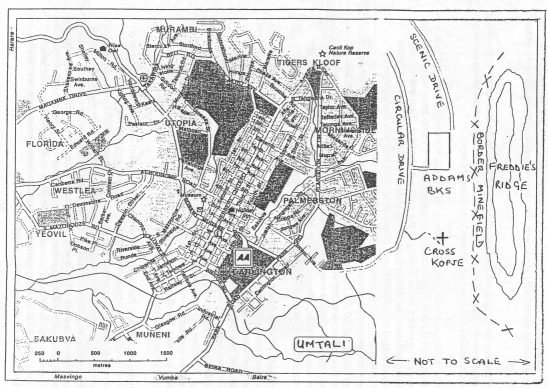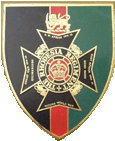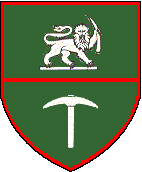Formation: 1st January 1964
6 INDEPENDENT COMPANY
THE RHODESIA REGIMENT / THE RHODESIAN AFRICAN RIFLES
A BRIEF HISTORY by G.D.P Morgan (Company Sergeant Major)
6 Independent Company Rhodesia Regiment came into being at a time that might be called the height of the Rhodesian War. It was a time when the
government of Ian Smith faced mounting pressure from erstwhile friends
around the world, and the degree of murderous terrorism escalated
dramatically.
The company - the last independent company of Rhodesians to be formed - began life on 1 May
1976 when the founding staff, drawn from various units within the army,
gathered at the girl's school in Umtali. This had already been named
Addams Barracks in honour of one of Rhodesia's fallen soldiers. The
company commander was Major John Peirson of the Rhodesian Light
Infantry; second in command was Captain Martin Knight-Willis MC of the
Rhodesian Special Air Service. From the Staff Corps came Company
Sergeant Major 'Taffy' Morgan, while from the RLI came C/Sgt Mike
Barrowman to take over as CQMS, and Sergeant George De Wet to become
Orderly Room Sergeant. The transport wizard was S/Sgt Henry Van Breda
from the Rhodesian Service Corps. Another welcome addition to the
company was Sgt Harald Sigurdsson, a colourful character who in a
previous life flew aircraft for Icelandic Airways, and had also been a
cordon bleu chef at Salisbury's prestigious Monomatapa Hotel.
Another staff member (unpaid) was Percy, the CSM's pekingese who was taken on strength as company mascot. Throughout the month of May, much was done to organise the troop accommodation, the cooking facilities, armouries magazines and office space ready for when everything turned up. Much help in these tasks was obtained from 5 Independent Company who also occupied part of Addams Barracks.
The headquarters block was situated a mere 200 metres or so from the Mozambique border. The block must have stood out like a sore thumb from the ridge on 'their side'. The ridge was later christened 'Freddie's Ridge' because of it's apparent popularity with Frelimo snipers wishing to 'zero' their rifles firing at the barracks.!
Despite the exposed position of the block, it was the place decided upon as the location of the company commander's office. (Some wag commented that promotion was a bit on the slow side anyway!)
The 1st of June arrived, but so far there was no sign of a
company – no officers, no NCOs, no men and no equipment. A
number of vehicles, however, did start to rumble in. After a furious
barrage of signals had been fired by the OC, things began to happen,
and promises from on high fell in great abundance.
The
men from the training depot at Llewellin Barracks arrived a few nights
later. They were part of intake 150, the first of a number of double
size intakes ordered by the government to build up strength in the
field to combat the increasing military threat at the border and the
internal terrorism. The draft of approximately 100 included sufficient
junior NCOs to fill the vacancies in three platoons.
Fortunately,
these NCOs were known to the CSM who had trained them at the Leader
Training Wing. What the JNCOs thought when they discovered that they
had fallen once again into the clutches of their former mentor (some
might say tormentor!), is not recorded. After the briefest rout of
defensive positions where they could take cover in the event of a night
attack (weapons had not yet arrived), the company were fed and bedded
down.
The junior officers and the senior NCOs
arrived the following day from officer training school at Gwelo, and
the business began of marrying up the personnel into the sub units that
would make up a fighting company. Signals between 6 Indep, 3 Bde HQ and
Army HQ shot to and fro like shuttlecocks. One signal in particular
caused a stir. It ordered the company to deploy for operations two days
after the arrival of the men. Major Peirson pointed out to the brigade
major that as weapons, ammunition and equipment had not arrived, and
the vehicles needed servicing, to say nothing of the fact the men had
hardly had time to find out the name of their platoon commander, the
deployment was out of the question. The company were given a reprieve.
In the days and nights that followed, the activity in the company lines
was feverish. Gradually, a semblance of order became discernable.
Platoons were able to test fire their weapons and roughly zero them,
and instruction was given in the use of certain weapons that had not
been available for instruction at the depot.
The
three platoon commanders, 2 Lts Conradie, McCall and Abbot, also
received instruction in simple demolition. The company deployed on 6
June - a memorable date - to St Swithin's Tribal Trust Land north of
Inyanga. It was an area that was criss-crossed by numerous tracks that
were becoming popular with terrorists and recruits exiting the country,
and for large parties of enemy entering from Mozambique to try their
luck. Enemy carrying parties bringing in explosives and munitions were
also active in this area.
The company set up it's
base camp on a rocky slope close to the BSAP post at Ruangwe, and an
aggressive patrol programme was immediately instituted. It was about
this time that Major Peirson was detached for duty running a JOC at
Rusape, and so Captain Knight-Willis took command. During this period
the company polished it's military skills and became very professional.
Because of the very rocky nature of the ground at the base
camp, the digging of defensive positions was all but impossible, and
sangars became the order of the day. Unfortunately, no sandbags were
available despite numerous requests through official channels. This
deficiency was to have sad repercussions later. Although there were
several reported sightings of terrorists, the patrols met with no
success.
One such sighting occurred at a place
approximately 25km north of Ruangwe. Captain Knight-Willis reacted by
getting together an ad hoc patrol from among those at the base camp and
deployed without delay. Unfortunately, whilst on route, a message was
received that the dirt road along which the vehicles were making best
speed, was mined. This meant debussing 10km short of the objective and
carrying out a speed march that would have made the cartoon character
'Road Runner' pause in admiration! The patrol reached the kopje only to
be told by a local that the 'bad men' had left an hour earlier. At 0330
hrs 31 August 1976, the camp was subjected to a sharp attack by
terrorists later estimated by the police to have numbered in excess of
90, supported by porters. The damage inflicted during the 30 minute
fire fight against the 30 members of the company, was quite severe. 12
servicemen were wounded. Severe wounds resulted in some soldiers
becoming paralysed, blinded or receiving permanent brain damage.
It was fortunate that the ammunition pit was not hit, but all
the vehicles that had been in the base area were put out of action.
At first light, a sweep of the area revealed discarded equipment and
blood spoor. Later police reports informed that 10 men believed to have
been killed in the fire fight had been found hidden among rocks not far
from the scene. Also at first light, helicopters carrying medical teams
landed and Cpl Basson the national service medical orderly who had done
so much excellent work caring for the wounded during the hours of
darkness, was able to relax. Also from one of the aircraft came many
hundreds of sandbags which, had they arrived when requested nearly two
months earlier, might have saved some of the men being hit by ricochets
and rock splinters produced by the enemy's rockets, medium mortars and
heavy machine guns. A week later, the company abandoned it's base camp
and moved back to Addams Barracks there to begin the tours of duty that
alternated between garrison protection and bush deployment, each tour
something of the order of 6 - 8 weeks duration.
Below
is an extract from the citation of the award of the Defence Force Medal
for Meritorious service to CSM Morgan. This specifically refers to the
battle in the St Swithins TTL.
He had personally
supervised inexperienced subordinates and guided them to achieve a high
standard of efficiency, discipline and professionalism. "In late 1977
he was in command of a small group of his company during the temporary
absence of their commander. "The group was attacked by an overwhelming
number of terrorists who carried out a determined and prolonged assault
which included heavy mortar, rocket and small arms fire". Despite the
weight of the enemy fire and casualties to his men, Sergeant Major
Morgan often exposed himself to the enemy to assist these casualties
and rally his men to drive off the enemy. "That his small group were
able to do so was undoubtedly due to the determined and calm leadership
shown by him in extremely hazardous circumstances," the citation said.
On occasion, the company took part in cross border operations
which added some spice to life. It was on one such excursion that Henry
Van Breda 'liberated' a fine enemy tractor in excellent working
condition. It was found to be of great use in Addams Barracks, but
unfortunately, 3 Bde HQ got to hear of it, and despite some hefty
argument, the company was outbrassed and lost the machine!
The
pattern for operations was set, the only change to routine being in the
area of deployment. Silver Springs, Chipinga, Inyanga and Melsetter
being some of the places that became well known to company patrols.
It was during one such tour at Chipinga, that the company got
involved in a hefty punch-up with Frelimo at Espungabera when 6 Indep
gave support to the Engineers working in the vicinity of the old
customs post. Some long range sniping between the 90mm guns of the
armoured cars and 'Fred's' 122mm rockets added to the spectacle. It was
about this time the company wag remarked in a suitable falsetto voice -
"My dear! The noise!!"
The company also operated in the
Ngorima highlands where several small operations carried out by certain
staff members dressed to appear like something from a minstrel show,
and which involved using a borrowed passenger bus, raised many an
indigenous eyebrow.
The Cashell Valley, where so many of the
Steyn family became victims of terrorism, also became well known to the
Company.
Although 6 Indep took no part in what can
be termed major engagements, the company strength was still being
whittled away. Twelve men lost at Ruangwe; one man killed in a vehicle
accident; one man killed whilst examining a captured rifle grenade, and
another severely wounded in the same incident. Nine men were wounded
during a follow up operation when they tripped a POMZ2 anti personnel
mine. One of the men - a Shangaan tracker - losing his leg. A further
two members of the company were badly wounded in two separate incidents
which involved rescue attempts of Mozambique refugees trying to cross
the minefield into Rhodesia. Unfortunately, there were no replacements
for these losses.
On the lighter side, Percy, by
now an acting sergeant was ambushed several times by certain miscreants
within the company and had his hair clipped. There was at least one
attempt to paint him in the regimental colours! During bush tours, 6
Independent Company probably received more visits from staff officers
than any other company. It didn't take long to find the reason for the
popularity especially when it was realised the visits always coincided
with meal times! News of Harald Sigurdsson's bush cuisine had spread
far afield. Numerous dignitaries also visited the company in Addams
Barracks, among them a retired British army general; a popular American
author, and Walter Cronkite, the American media news-hound.

General
Peter Walls also
paid a visit and was awarded a company beer mug. It was on this
occasion the A/Sgt Percy nearly blotted his copy book when he took a
more than casual interest in the general's trouser leg! It was also at
this time the general was informed that the dog, now the shape and size
of a Pekingeses, had been, when the company first begun it's patrol
programme, a full size Alsatian!
For visitors, the
main point of interest was the view into 'enemy' territory that could
be obtained from the heavily protected observation post on top of the
HQ block.
Many options were expressed among the
company staff as to how well the OP would stand a direst hit from a
heavy weapon. Speculation was rife as to whether the whole construction
would collapse and manage to reach down as far as the OC's office, or
only penetrate as far as Harald Siggurdsson's bed-room one floor below
An escape route for the observers if the worst came to the
worst, was erected. It was a fireman's pole, and this provided many
hours of fun for the CSM and the CQMS! By the time 150 intake were due
to leave their full time service commitment, moves were afoot to
replace the European soldiers with African troops. The first
experiment, so far as 6 Indep was concerned, was a disaster - or would
have been has the small (experimental) group of men been deployed. It
transpired the African soldiers had only been in the army for six
weeks! Following a flurry of signals, it was agreed the men should be
returned to their depot at Essexvale to receive a further three weeks
training. Fortunately, someone eventually saw reason and the men were
not returned. At about this time, a change of command occurred and
Major Peirson was replaced by Major Terry Leaver. Also about this time,
Captain Knight-Willis returned to Special Forces.
The
company was rebadged Rhodesian African Rifles and regular African
soldiers (thankfully fully trained) replaced the national servicemen
although leadership at platoon commander and platoon sergeant level
continued to fall on the shoulders of selected national servicemen.
Before the change over occurred, however, Major Leaver managed to get
himself blown up on a mine. Luckily the 2.5 he was driving took the
full force of the explosion fully justifying the protective measures
installed, and he was not hurt.
In the same
operation, the CSM drove his ammunition laden 2.5 over a British mark 5
mine, luckily missing the detonator. It exploded when the troop carrier
behind ran over it. Fortunately, among the load of white faced and for
once speechless troopies dangling over a crater, there were no
injuries. During their stints at Addams Barracks, the company prepared
en elaborate trench and bunker system. A large garage forecourt size
fuel tank was obtained, fitted with a door, and buried and camouflaged
at the end of the trench system. In this was hidden from the prying
eyes of ammunition inspectors, the 'buckshee' ammo which gave the
company a realistic crack of the whip when it came to training shoots.
The war had now reached the stage where a simultaneous attack
from Mozambique and Zambia plus Botswana was in prospect. Contingency
plans had long been drawn up and these included areas where the company
would operate and make the life of any invading armoured force a short
but miserable one.
After a while the threat passed,
and although operations were not scaled down - if anything they
multiplied - it was obvious there was going to be a 'political'
solution. The end came one night in April 1980 when the cease fire came
into effect at 2300hrs. On that day, the company were fully mobilised,
carrying out vehicle patrols throughout Umtali and it's environs in the
expectation (some bloodthirsty soldier might say in hope), that
Mugabe's supporters would be tempted to come out into the open with
their weapons and let fly. Nothing of the sort happened. However, at
five minutes to the magic hour, the CSM approached Forbes border post
and was met with such a burst of fire from across the border that he
was persuaded, together with his crew, to debuss in quick time and seek
shelter behind a wall of sandbags. There was just time to give
consideration to the thought that the firer might have been an ex-150
intake man!!
Then it was all over. Arguably, 6
Indep had received the final shots of the war. On the stroke of
2300hrs, 6 Independent Company became part of Mugabe's communist army.
6 Independent Company had fought their war. Things were now changed to
a peacetime footing and in the pipeline was the merger of Independent
Companies to form the new 3 RAR under the command of Lt Col TCD Leaver.
By this time however, the writer had left to seek green pastures that
he hoped would be less tinged with red.

















